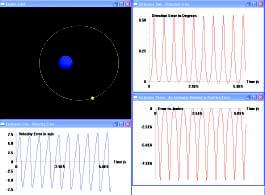| 2006 |

|
YEAR BOOK |
Synge Street CBS, Dublin
|
A hodograph is the curve traced out by the tips of the velocity vectors of a moving body when these vectors are all translated to a common origin.
|

Hamilton's hodograph theorem follows from the fact that there is a vector � which we call the "Hamilton vector" � that remains constant throughout the motion.
Other mathematical physicists of Hamilton's era and just after it mentioned the hodograph in their writing, but in the twentieth century this concept was rarely mentioned in physics books.
For anyone who is learning computer simulation techniques in physics, the motion of planets and satellites is a very attractive application of simulation methods. The issue of the accuracy of a particular simulation technique is always of central importance. In our project we use the hodograph of the motion and the constancy of the Hamilton vector to test the accuracy of a number of simulation techniques for the Kepler problem. We have developed three estimators of the simulation error based on the use of hodographs. The methods we describe are a fresh approach to checking the accuracy of such simulations.

The goals of our project are:
� to provide a new simple technique for people wishing to evaluate the accuracy of various simulation methods in the Kepler problem,
� to highlight Hamilton's invention of the hodograph and his theorem that the hodograph of the Kepler problem is always a circle,
� to point out the importance and usefulness of the Hamilton vector,
� to highlight the work of Feynman and others on the derivation of the properties of Keplerian orbits from the hodograph.
Keith, Adrian and Sandeep entered their project in the Senior Group Section in the Chemical, Physical & Mathematical Sciences Category at the BT Young Scientist & Technology Exhibition and won The Best Group Award. Their teacher was Mr Jim Cooke.
| This article was sponsored by Oldbury Publishing Limited. |
|---|